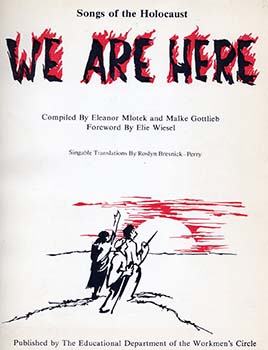A song of the Vilno ghetto by Leyb Opeskin (1908-1944) one of the founders of the partisan movement. He was killed the day before the liberation of Vilno. Composer unknown.

Why in the past was the sky so much lighter,
Joy everywhere to be seen?
Oh, why is the sun which could never be brighter
Clouded now, angry and mean?
Today the sky cries joined by street and by dwelling,
The heart too is grieving so still.
Say, can we forget, can our thoughts stop retelling
The joys bygone hours would fill.
Dry all your tears, forget your misgivings,
Mourning the past’s not for you!
A new day is coming, most certainly coming
When sunlight will sparkle a new.
Far vos iz der himl geven nekhtn loyter,
Fun freyd hot geshaynt yede gas?
Far vos iz di zun aza likhtike, royte,
Farkhmuret haynt, beyz un in kas?
Es veynt haynt der himl, dos hoyz un dos gesl,
Es troyert dos harts shtilerheyt,
Tsi ken men fargesn, vi ken men fargesn
Fargangene shoen fun freyd?
Vish oys dayne trern, farges dayne zorgn,
Tsu troyern iz nit keday,
S’ken zayn shoyn, az morgn, s’iz zikher, az morgn
Vet oyfshaynen zun af dos nay!
פֿאַר װאָס איז דער הימל געװען נעכטן לױטער,
פֿון פֿרײד האָט געשײַנט יעדע גאָס?
פֿאַר װאָס איז די זון אַזאַ ליכטיקע, רױטע,
פֿאַרכמורעט הײַנט, בײז און אין כּעס?
עס װײנט הײַנט דער הימל, דאָס הױז און דאָס געסל,
עס טרױערט דאָס האַרץ שטילערהײט,
צי קען מען פֿאַרגעסן, װי קען מען פֿאַרגעסן
פֿאַרגאַנגענע שעהען פֿון פֿרײד?
װיש אױס דײַנע טרערן, פֿאַרגעס דײַנע זאָרגן,
צו טרױערן איז ניט כּדאַי,
ס׳קען זײַן שױן, אַז מאָרגן, ס׳איז זיכער, אַז מאָרגן
װעט אױפֿשײַנען זון אױף דאָס נײ!
Song Title: Far Vos Iz Der Himl

Compiled by sisters Malke Gottleib and Chana Mlotek, this collection of 40 songs, issued on the occasion of the 40th anniversary of the Warsaw Ghetto Uprising, reflects the suffering, despair, longing, as well as the strength, hope and courage that led the last remnant of enfeebled Jews to take up arms against the mammoth Nazi war-machine. Save for five songs, this compilation comprises songs that were actually written or sung in the ghettos and concentration camps. Four exceptions written after the war: “Babi Yar,” “Moyshelekh un Shloymelekh,” “Kadish,” and “Mayn mame hot gevolt zayn oyf mayn khasene” are often presented at commemorative gatherings and were therefore included. The fifth song “Am Yisroel Khay” was written in a D.P. camp and is an affirmation of the will of the survivors to build new lives for themselves, holding high their belief in the endurance of the Jewish people. To enable readers and singers not conversant with the Yiddish alphabet to utilize this collection, We Are Here! Songs of the Holocaust provides parallel transliterations and singable English translations by Roslyn Bresnick Perry.